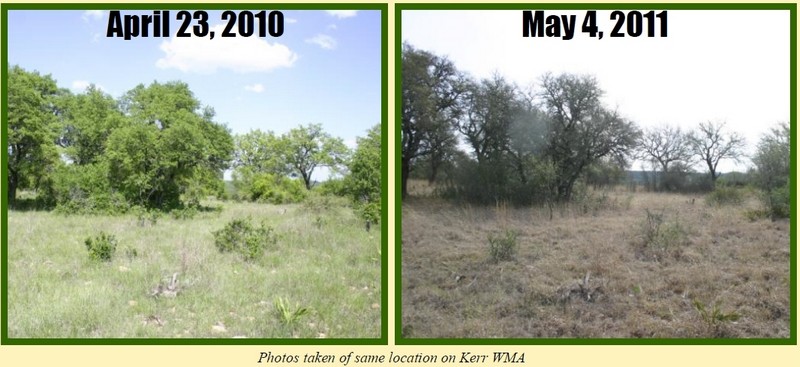White-tailed deer hunting in Texas is big time and everyone has heard of the Kerr Wildlife Management Area (WMA), located just west of Kerrville, Texas, in Kerr County. The WMA offers public hunts for many game species, so many hunters are familiar with Kerr WMA hunting. It’s a great place to hunt and anyone selected for a hunt out there is in for a treat. Additionally, the WMA pioneered whitetail genetic research in Texas and Texas Parks and Wildlife Department (TPWD) does a great job of managing the habitat found on the property. Here is TPWD’s account of the drought of 2011:
As was the case all over Texas, 2011 was the second driest year ever recorded on the Kerr Wildlife Management Area (WMA) since 1952. Total rainfall for the year was 10.92” which is 15.2 inches less than our average rainfall of 26.13”. Approximately one-third of that fell in the month of December. Though it did not beat our record low of 8.25” in 1956, it was just as devastating. Most of the rainfall came in several small events which resulted in little more than keeping the dust down.
The typical emergence of new grass and forb growth was non-existent. Some woody plants managed to leaf out and put on growth, but it was not long before they also shut down. Due to the lack of spring growth, deer were forced to begin eating available low protein browse early which depletes their winter food source. This became apparent around mid-summer as brush showed signs of heavy use and deer began showing poor body conditions. Looking across the landscape one could see large areas of defoliated oaks and rusty colored cedar trees.
Landowners were justifiably concerned about the welfare of wildlife on their ranches. Despite high feed prices, many of them chose to continue supplemental feeding on into the fall and winter. This drought has taken a toll on all wildlife. It not only affects health and reproduction, but it also changes the movement and activity of animals as food and water sources become dangerously limited. This was evident to many as they were seeing half the expected number of deer along survey routes, but yet there was no indication of an unusually high mortality. It was unclear how to move forward in this extreme situation.
There was even some debate among biologists about whether to greatly reduce deer populations to hopefully avoid a die off, or to maintain the current population so that if a die off occurred the herd would have enough individuals to recover. Fortunately, we were blessed with some fall moisture that resulted in considerable forb growth which improved the outlook…at least for the winter.
This past deer season the Kerr WMA estimated its lowest historical fawn crop (wildlife and habitathealth so we chose to make our normal harvest even though it could result in a considerably lower deer density for next season. We have always followed a simple rule, “If you can grow plants then you can grow animals, if you cannot grow plants then you cannot grow animals.” With fewer animals on the range we hope that the plants will make a faster recovery, and eventually we will grow more animals once things return to “normal.”
